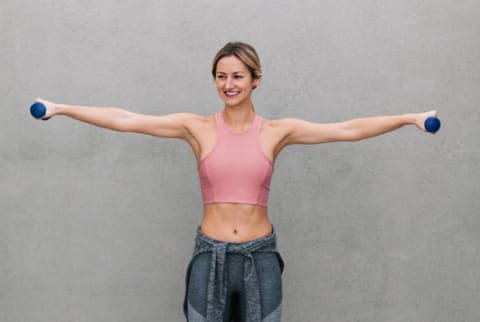Advertisement


Once dominated by men who strived for superhero physiques, the art of weightlifting has gone mainstream over the past decade as both men and women are hitting the gym to lift heavy handweights and load their barbells. While weightlifting certainly yields a positive aesthetic result, it also has proven health benefits including a lowered stress level, better bone density, and improved balance.
Unfortunately, weightlifting comes with some consequences—when lifting heavy, it's easy to throw out your back with one wrong move, or maybe the size of a weight leaves you too intimidated to start at all.
In July, a study found that lifting light weights (but doing more reps) yields the same results as lifting heavy ones. To which we say: Hallelujah!
As we work to shake up our fitness routines in the new year, we decided to get to the bottom of how effective light weights really are and why so many people prefer them. So we consulted fitness experts Lisa Tanker, Kristin McGee, Krista Stryker, and Jesse Barton. Here's what they had to say.
Why smaller weights work
If you're worried about small weights leading to puny—if any—muscles, think again. While Lisa notes that lifting heavy will lead to muscle definition, more reps with smaller weights may be just as effective.
"There was once a misconception that light weights would not get you the results, and now, a few early studies (as well as real-world examples of everyday people getting results) are confirming that you can achieve the same aesthetic look with the proper light weight training."
Lifting lighter weights also allows you be more precise and have more control over your movements. "You can go through an entire range of motion with smaller weights, and you can lift them without compromising your other body parts," says Kristin.
Lighter weights and injury prevention
When it comes to "preserving" your body and long-term physical health, lifting light will do you a lot more favors. While heavy weights put tons of pressure on the joints and often get other muscles involved that you don't want to strengthen (like your neck), lighter weights get the job done and let you walk away from your workout injury-free.
"Significantly more injuries are associated with heavy weights," says Lisa. "By incorporating light weights, you do not have to be as strong to execute the exercise and can concentrate on your form to successfully and safely complete your workout program."
Krista adds that using light weights or even no weights at all while strength training is so much better for the long-term health of your joints. "And it's much less likely that you'll get injured by dropping a light weight on your foot than it is with a heavy one," she adds.
What you should keep in mind the next time you head to the gym
If light weights just aren't your thing, consider going heavy. According to Jesse, it all comes down to preference.
"I think that the bottom line comes down to what a client prefers, what their time commitment is, and what they have available to them in terms of equipment," she says. "You can obviously get excellent results with heavy weight, light weight, and body weight exercises. Some people love lifting heavy as it brings a sense of accomplishment. And some are intimidated by free weights. But as long as proper form is executed and the number of reps fatigues the muscles, they will undoubtedly see results."
Good luck out there.